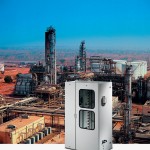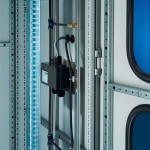Plants for the oil and gas industry set particular demands with regard to explosion protection. One effective measure within the framework of explosion protection is to accommodate electrical equipment in an appropriately pressurised enclosure. If high power dissipation or high ambient temperatures make it necessary to provide climate control for such enclosures, however, there are a number of additional points to take into account.
Reimund Hering, Michael Maage
Rittal has developed explosion-protected enclosures with integrated cooling units for the video systems monitoring oil and gas installations in Algeria. Special system enclosures from the company’s TS 8 enclosure range form an optimum basis for satisfaction of the wide-ranging project-specific demands. These enclosures also permit the use of devices and components which do not themselves comply with explosion-protection requirements, without affecting the qualification for installation of the overall solution in locations subject to explosion hazards. The system enclosures are available for applications in Zone 2 (gases). Corresponding solutions for Zone 22 (dust) are in preparation. The suitability of the overall system for use in hazardous areas is guaranteed by an enclosure pressurisation system in accordance with the DIN EN 60079–0 and DIN EN 60079–2 standards. A constant overpressure of 1.5 to 2 mbar ensures that, during operation, inert gas is only able to escape from the enclosure, but no explosive gases from the surroundings are able to penetrate into the enclosure. In addition to the external inert gas supply, it is ensured that the rate of leakage from the enclosure never exceeds a certain value – meaning 10 l/min in the case of the TS 8 enclosure used. During commissioning, it is first necessary to eliminate any explosive gases from within the enclosure. To this end, the enclosure is flushed with an overpressure of 20 mbar. In operation, the pressurisation system then monitors the pres-ence of adequate overpressure and disconnects the electrical devices from the power supply if the pressurisation fails or the door is opened. All components of the pressurisation system are integrated into one side panel of the TS 8 enclosure.
Cooling in a separate enclosure
But those were not the only challenges to be mastered in connection with this application. If the internal temperature in the enclosure increases excessively, whether due to the power dissipation from the installed components or due to high ambient temperatures, it becomes imperative to provide climate control. This climate control must be integrated in such a way that it does not disturb the functionality of the pressurisation system for explosion protection. At the same time, the cooling system must itself be designed to comply with the relevant explosion protection specifications.
The cooling system used is a unit with a cooling output of 3.3 kW, and is accommodated in a separate enclosure alongside the enclosure for the actual equipment. The challenge for the design engineer is to arrange the external air circuit and the components of the cooling circuit such that the effective cooling output is maintained, but all explosion-protection requirements are nevertheless fulfilled. The first step is to join the two enclosures in a manner which enables the pressurisation system to serve also the cooling system enclosure. To this end, numerous cut-outs are provided in the special partition between the two enclosures to permit a simple gas and temperature exchange. As the leakage rate must not exceed a prescribed level, the cooling system enclosure must also be sealed accordingly. The evaporator, for example, is mounted on the outer wall with a gas-tight joint.
All components of the external air circuit must naturally be suitable for the hazardous environment. This includes, for example, special explosion-protected fans, with which sparking or hot surfaces can be excluded. To permit the enclosures to be erected outdoors, a corresponding roof provides protection against direct sunlight and rain. The inspection panes of the enclosure are high-strength safety glass.
Fully assembled
During the course of the cooperation between Rittal and the customer, the manufacturing and assembly processes were also optimised. The enclosures are delivered to Algeria fully assembled and configured, and thus only need to be connected to the corresponding media. Rittal takes care of all interior installations and testing of the installed systems on behalf of the customer. One especially important aspect is the fact that the flawless functioning of the explosion protection system is already factory-tested and certified. The certification rules require renewed testing each time an explosion protection system is modified in any way. If the systems were to be installed on site in Algeria, therefore, the explosion protection testing would also have to be performed there. This would automatically mean a significantly greater outlay and much more complex logistics.
With its modular enclosure concept, Rittal establishes ideal prerequisites for uncomplicated verification of the overall explosion protection by the customer. The safety solution for the facilities in Algeria will be completed on schedule and the customer is very satisfied with the current status of the project. On the basis of the positive experience gained with this project, concrete preparations have already been initiated for further follow-up projects.
Online-Info www.cpp-net.com/2309434


Flammable dust-air mixtures are an equally major hazard in the chemicals industry and especially in the foods industry. Where highly concentrated, combustible dust clouds come into contact with an ignition source in an enclosed, oxygen-rich environment, explosions are a constant risk. In such hazardous zones, therefore, it is only permissible to install electrical equipment which possesses corresponding ATEX approval. This applies in particular to the cooling units used for enclosure climate control. To be able to offer cooling units with ATEX approval also for the lower output range, Rittal has extended its cooling unit series to include a 500 W model. It carries a manufacturer declaration for use in Zone 22 and can thus be taken into service in environments subject to dust explosion hazards. The cooling unit can be supplied with either Basic or Comfort controller. A special external fan design and special seals on the enclosure side satisfy all safety-relevant requirements. For safety reasons, the control and setting functions have been moved to inside the enclosure. Remote monitoring of the cooling unit via a separate interface is offered as an option. Alongside cooling units with a cooling output of 500 W, further models are available for the output classes 1000 and 1500 W.
Share:








